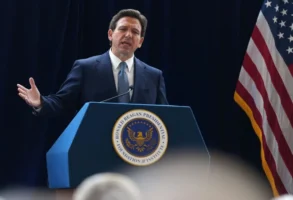
Published December 16, 2021
With culturally leftist schooling only lately ranked as a top-tier political issue, conservatives have yet to take full measure of the woke education threat. Beyond better-known dangers such as critical race theory, the 1619 Project, action civics, and lessons in gender fluidity lies the “world-history movement” — educators bent on forming a generation of “global citizens” who reject both American patriotism and any sense of indebtedness to our Western heritage of liberty.
For decades, the world-history movement has quietly advanced in the slipstream of higher-profile changes in curriculum. The battle over National History Standards for the United States in the mid 1990s — a breakthrough moment for the education Left — focused on the U.S.-history component of the proposal. Critics largely ignored the equally troubling, and thoroughly globalist, National Standards for World History. The 2014–15 battle over the College Board’s revisionist AP U.S. History and AP European History frameworks did much to highlight their globalist underpinnings. Yet widespread adoption of the still more radical AP World History course went largely unnoticed.
This fall, South Dakota governor Kristi Noem rejected draft state-history and civics standards that mandated political protests (“action civics”), short-shrifted high-school U.S. history, downplayed America’s British heritage, and left the role of religion in American history largely unacknowledged. Yet no one even noticed that the draft standards’ adoption of the College Board’s AP World History approach had effectively eliminated the study of Western civilization from South Dakota’s schools.
To be sure, given this country’s leading role in world affairs, Americans ought to study the history and character of other nations and civilizations. The world-history movement has something very different in mind, however, than a conventional “area studies” approach. Rather than teaching the history of China, Russia, the Islamic world, or Africa in sequence, the world-history movement aims to deconstruct these cultural and national identities.
The new world-history curricula employ several techniques to break down any sense of national or civilizational distinctiveness. Instead of covering, say, Chinese history as part of a sequence, world-history courses strive to study virtually every global region simultaneously. So, rather than highlighting the distinctive character of particular civilizations and cultures, world history now focuses on such things as international trade and globally pervasive patterns of social organization. The message is that human societies have always been mutually dependent and are more alike than different. This teaching is offered less to supplement or nuance our understanding of national or cultural differences than to challenge the very idea of civilizational identity. It thereby makes it nearly impossible to grasp the distinctive nature of a given nation or culture. Behind it all lies the desire to replace pride in our Western and American heritage with a commitment to global citizenship.
To see how this works in practice, consider a unit from the College Board’s AP World History framework, a model for this new approach. AP World History, Unit 3, covers “Land-Based Empires” from 1450 to 1750. This includes empires in China, India, the Middle East, Persia, Russia, Europe, and beyond. The course homes in on commonalities uniting these many territories: The various empires in question relied on gunpowder and cannons to acquire and retain power; absolute rulers consolidated centralized control through the recruitment of bureaucratic elites; religion, art, and monumental architecture were deployed to legitimize the power of the various rulers; and tax-farming (authorizing private individuals to collect state taxes) and similar techniques helped generate revenue.
That’s it. This is what we are supposed to take from 300 years of world history. What a supremely boring and utterly superficial approach. Yet what else could emerge from thoroughly decontextualized comparisons of so many societies at once — especially given the focus on cultural commonality. Instead of examining, say, a given civilization’s most characteristic art forms for their distinctive styles and techniques and the ideas they embody, the AP World History course repeatedly hammers home the reductive truism that art can be used to legitimate political power.
Gunpowder takes on an outsized importance in the AP World History course since it serves as a least common denominator uniting empires across vastly different cultures. We shoot each other, and so, apparently, we all belong to one big, happy human family. Thus does the virtual ban on attention to civilizational particularity push toward a shallow materialism. In place of stories, battles, great individuals, distinct and complex social orders, deeply held religious convictions, and distinct ways of life, we get thin sociological truisms such as “Land-based empires consolidate centralized power via the recruitment of bureaucratic elites.”
This approach utterly mangles the story of Europe, rendering its most distinctive characteristics all but invisible. In order to highlight commonalities among the world’s authoritarian global empires, AP World History courses, when they bring Europe into the picture, emphasize the divine right of kings and the reign of Louis XIV. Yet the unique thrust of Europe’s history is the story of liberty, particularly how it played out in England. England’s rights-based constitutional monarchy created a powerful alternative to French absolutism, and this eventually set Europe as a whole apart from the rest of the world. Unfortunately, the story at the heart of America’s European heritage is treated only in fragmentary fits and starts. That which makes the West distinctive and important is all but lost.
Sad to say, this is intentional. The world-history movement exists to render the West’s achievements invisible, and in this it succeeds all too well.
Small wonder that historian David Randall’s withering assessment of the AP World History curriculum for the National Association of Scholars convicts it of “simplified, vapidly generalized” accounts, stripped of “all historical particularity.” Randall notes the course’s “astonishing erasure of as much European and American history as possible,” and he concludes by condemning “the structural distortions imposed by [AP] World History’s disciplinary assumption that the marginally important connections between the different world regions are world history’s heart.”
A 2017 study by Michael Lovorn, Patrick Manning, and Molly Annis Warsh, titled “Entering a New Era in World History Education,” identified world history as the fastest-growing subject in U.S. middle schools and high schools. When the study of Western civilization fell from grace in higher education in the late ’80s and early ’90s, states started calling the sections of their history standards devoted to anything other than America “world history.” Initially, K–12 content remained largely unchanged. Familiar units on classical Greece and Rome and medieval and modern European history, with units on non-Western history thrown in, were simply relabeled “world history.” But gradually, K–12 world-history courses have proliferated, with content reworked along lines favored by the contemporary globalist-history movement. Last summer, as noted, leftist state education bureaucrats came within a hair’s breadth of imposing the new orthodoxy on even ruby-red South Dakota. Deep-blue Massachusetts adopted this approach in 2018. Every state is now at risk.
The scholarly literature of the world-history movement bemoans the West’s post-Brexit retreat from globalism, openly aiming to undercut both American patriotism and “heritage” views of the West. During the Trump administration, the world-history movement proudly offered itself as the antidote to Trump’s vision of American greatness.
The world-history movement’s problems go well beyond its political agenda, however. World history, in the globalist sense, is a specious subject. There is virtually no truly global history. Human social life plays out at the local, national, and civilizational levels. However desperately the world-history movement works to elevate international trade, shared technology, and thin sociological commonalities into the central human story, this approach does not and cannot work.
Aspiring teachers take college or graduate coursework on the history of America, Europe, or various world regions, not the history of the globe. There is no academic discipline of global history for the very good reason that there is no such thing as a global civilization.
The notion of globalization itself makes no sense except as a process that gradually crosscuts and erodes preexisting national and cultural differences. Yet the world-history movement makes those preexisting differences impossible to comprehend, thereby rendering the concept of globalization itself incoherent. Globalization can be studied only as a supplement to, not a substitute for, conventional national and civilizational history. That means the world-history movement will forever remain a political agenda in search of a coherent curriculum.
The proper response to this latest permutation in woke education is clear. Restore Western civilization to the K–12 curriculum, supplemented by exemplary units on non-Western history. All of this should be taught in the traditional, regionally focused, sequential manner. Now that parents are organizing to take control of local school boards and to reform state standards, this goal is entirely achievable. Instead of passively taking their marching orders from politically biased academics and woke-education bureaucrats, governors and state legislatures should seize control of state standards, while local school boards should take charge of curricula, through the democratic process. Once the public savvies up to the world-history movement and its folly, the study of Western civilization can be returned to its proper place in our schools.
Stanley Kurtz is a senior fellow at the Ethics and Public Policy Center.
Stanley Kurtz is a Senior Fellow at the Ethics and Public Policy Center. Beyond his work with Education and American Ideals, Mr. Kurtz is a key contributor to American public debates on a wide range of issues from K–12 and higher education reform, to the challenges of democratization abroad, to urban-suburban policies, to the shaping of the American left’s agenda. Mr. Kurtz has written on these and other issues for various journals, particularly National Review Online (where he is a contributing editor).








